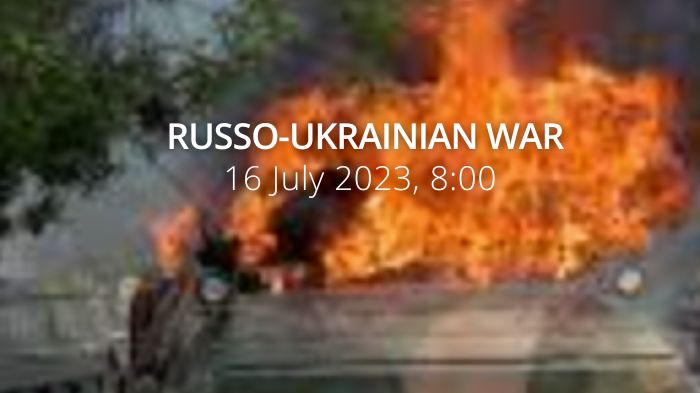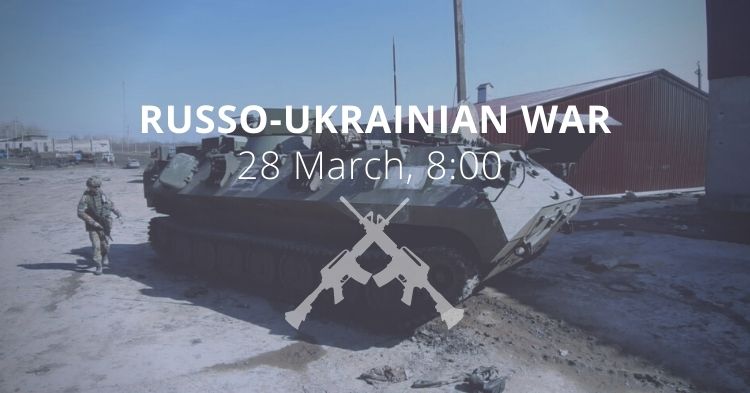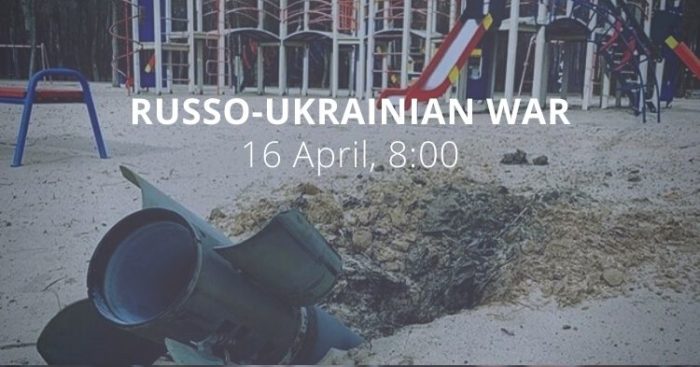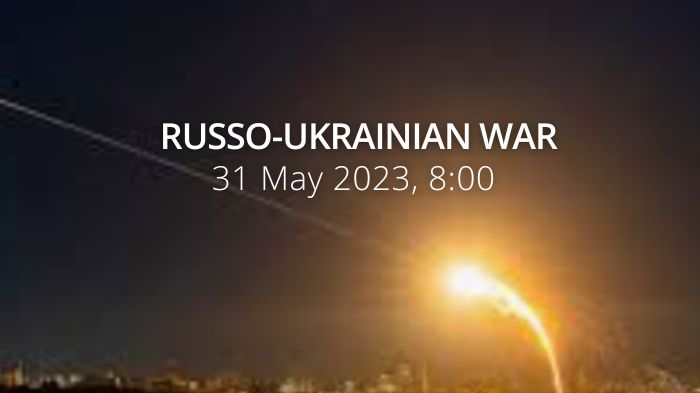Ukraine adapts counteroffensive tactics after heavy equipment losses. Russia reportedly shot down nine Ukraine drones over Crimea. Over 50 Russians found guilty of war crimes in Ukraine – Ukraine's Prosecutor General.
Daily overview — Summary report, July 16
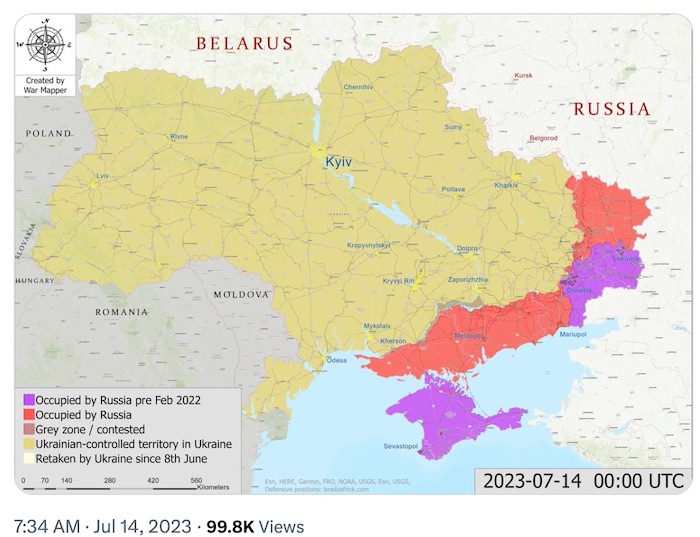
The General Staff’s operational update regarding the Russian invasion as of 18.00 pm, July 16, 2023 is in the dropdown menu below:
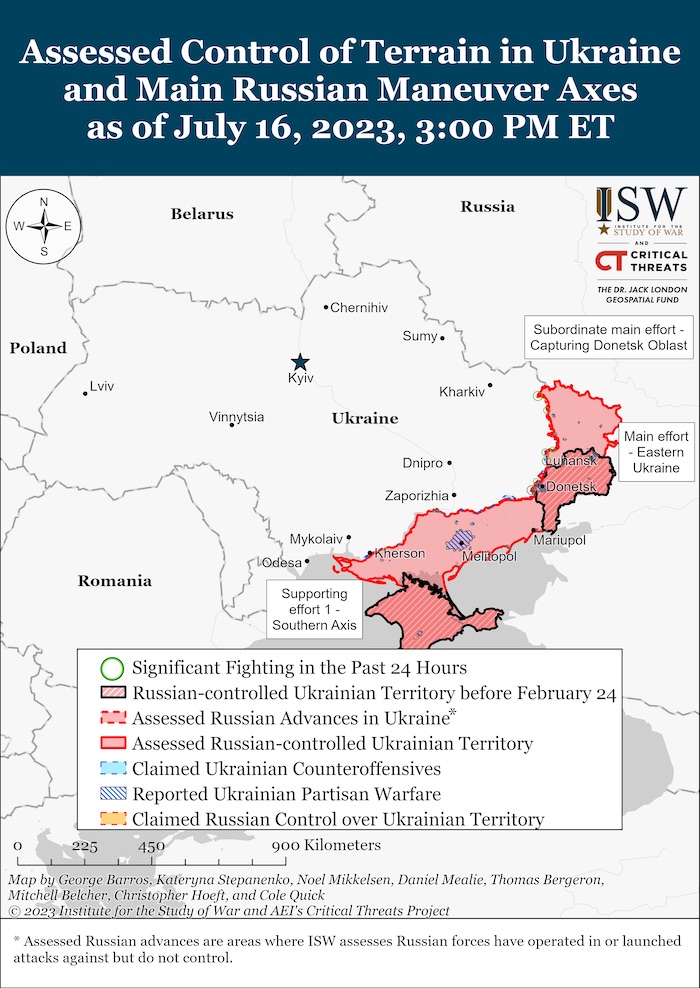
Last night, the Russian Federation launched yet another attack on Ukraine using anti-aircraft guided missiles. Information on the aftermath of this terrorist attack is currently being updated.
On July 15, Russia launched 2 Iranian Shahed UAVs, 2 Kh-22 cruise missiles, and 2 anti-aircraft guided missiles. Air defence of the Ukrainian Defense Forces intercepted 2 UAVs.
In addition, the enemy launched 40 airstrikes and 46 MLRS attacks.
The likelihood of missile and air strikes across Ukraine remains high.
The adversary focuses its main efforts on Kupiansk, Lyman, Bakhmut, Avdiivka, and Mar’inka axes, with 39 combat engagements taking place On July 15.
- Volyn and Polissya axes: no significant changes. No signs of the formation of enemy offensive groups were found. Certain units of the armed forces of the Republic of Belarus continue their missions in the areas bordering Ukraine.
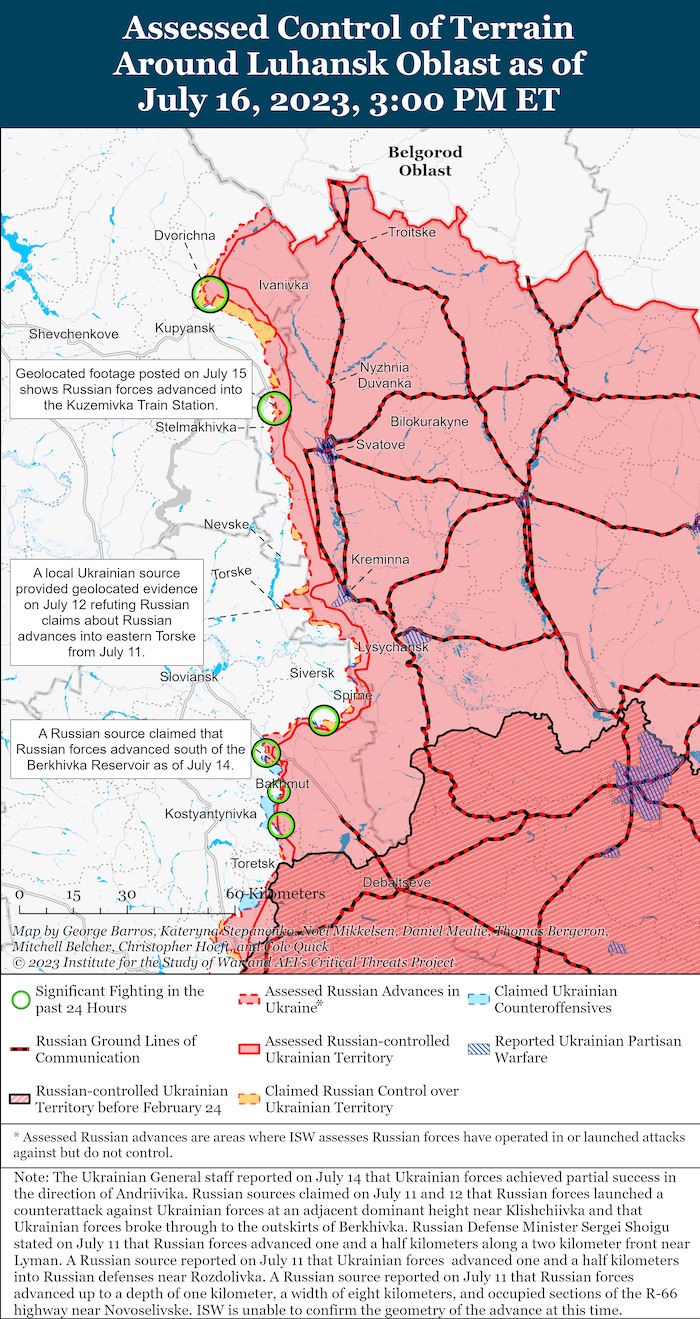
- Sivershchyna and Slobozhanshchyna axes: the adversary continues to maintain its military presence. On July 15, the invaders launched airstrikes in the vicinities of Volfyne (Sumy oblast) and Ustynivka (Kharkiv oblast). The adversary fired mortars and artillery at more than 20 settlements, including Karpovychi, Zaliznyi Mist (Chernihiv oblast), Boyaro-Lezhachi, Bilokopytove, Prohres (Sumy oblast), Sotnyts’kyi Kozachok, Kozacha Lopan’, Veterynarne, and Krasne (Kharkiv oblast).
- Kupiansk axis: the Ukrainian troops are standing their ground. On July 15, the adversary conducted unsuccessful offensives south of Novoselivs’ke (Luhansk oblast). The invaders launched an airstrike in the same area. Dvorichna, Krasne Pershe, Kolodyazne, Zapadne, Novomlyns’k, Kyslivka, and Berestove (Kharkiv oblast) came under artillery and mortar fire.
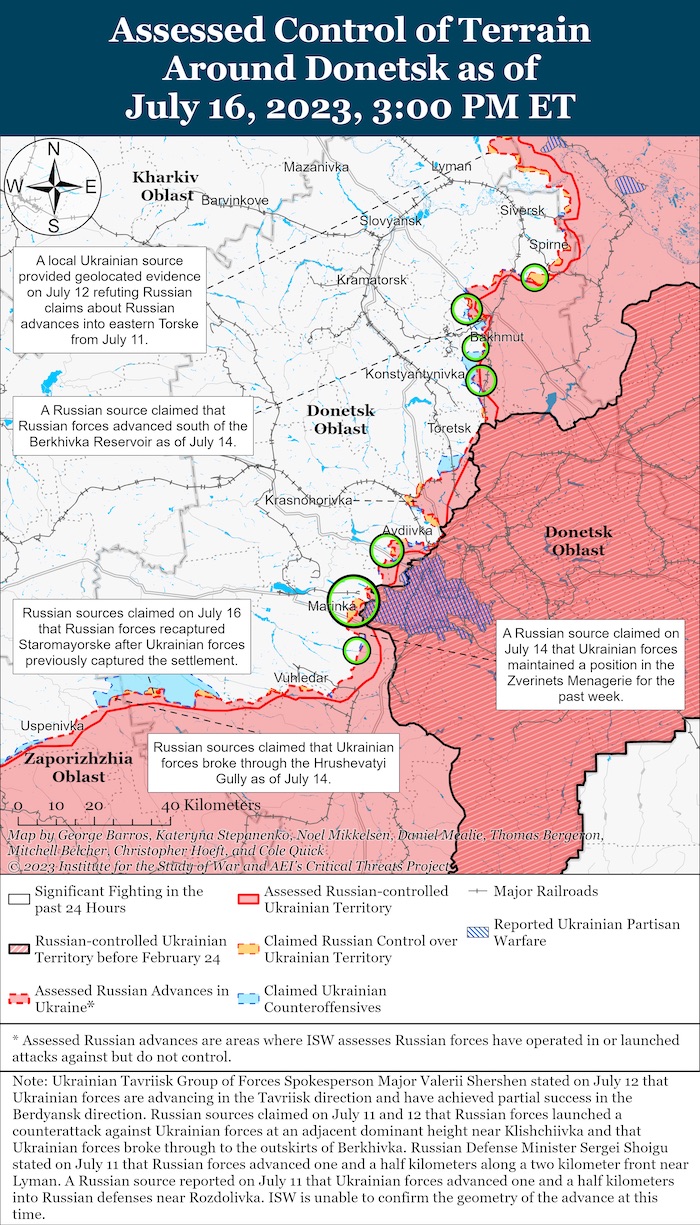
- Lyman axis: On July 15, the adversary conducted unsuccessful offensives east of Vesele (Donetsk oblast). The invaders launched airstrikes in the vicinities of Nevs’ke, Bilohorivka (Luhansk oblast), Spirne, Vesele, Ivano-Dar’ivka, Fedorivka and Rozdolivka (Donetsk oblast). The settlements Nevs’ke, Bilohorivka (Luhansk oblast), Verkhn’okam’yans’ke, Tors’ke, Spirne, and Rozdolivka (Donetsk oblast) were shelled with artillery.
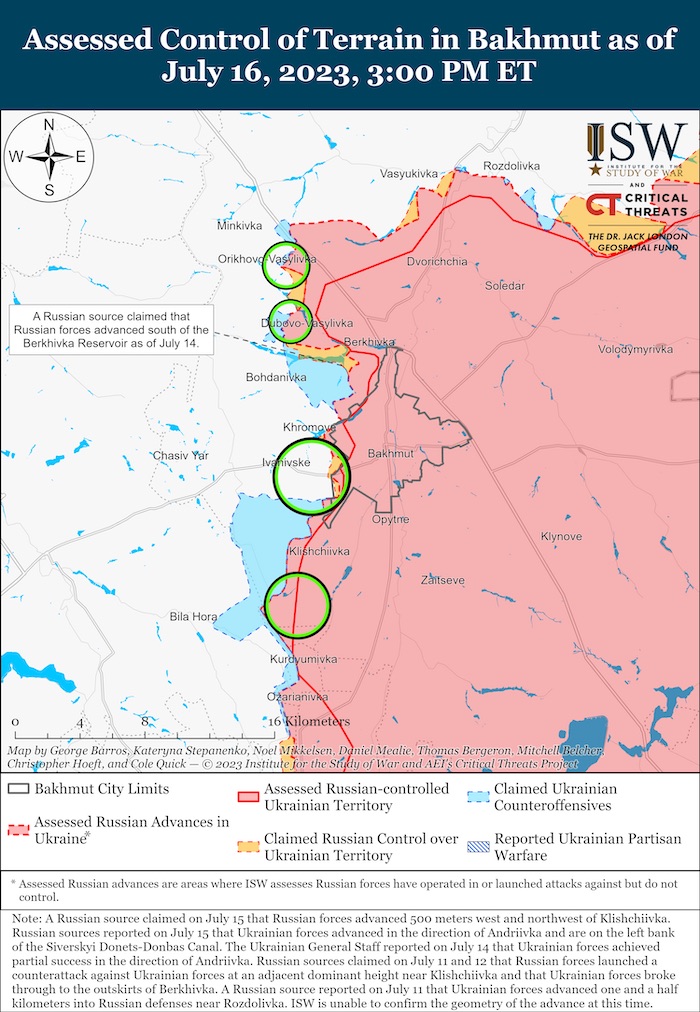
- Bakhmut axis: the Ukrainian defenders successfully repelled all enemy attacks southwest of Andriivka (Donetsk oblast). The adversary launched airstrikes near Kostiantynivka and Dyliivka (Donetsk oblast). More than 15 settlements, including Markove, Khromove, Dyliivka, Vasyukivka, and Pivnichne (Donetsk oblast), suffered from enemy artillery shelling.
- Avdiivka axis: the enemy conducted unsuccessful offensives in the vicinity of Pervomaiske and launched an airstrike near New York (Donetsk oblast). At the same time, the adversary fired artillery at more than 15 settlements, including Nevelske, Pervomaiske, Stepove, Sjeverne, and Avdiivka (Donetsk oblast).
- Marinka axis: the Ukrainian Defence Forces continue to hold back the Russian offensive in the vicinity of Mar’inka. The enemy also launched an airstrike The invaders shelled more than 10 settlements, including Krasnohorivka, Mar’inka, Katerynivka, and Heorhiivka (Donetsk oblast).
- Shakhtarske axis: the enemy conducted unsuccessful offensives in the vicinity of Novomykhailivka and launched airstrikes in the vicinity of Blahodatne, Makarivka, and Rivnopil’ (Donetsk oblast). The invaders shelled the settlements of Velyka Novosilka, Vuhledar, Prechystivka, Zolota Nyva, and Blahodatne.
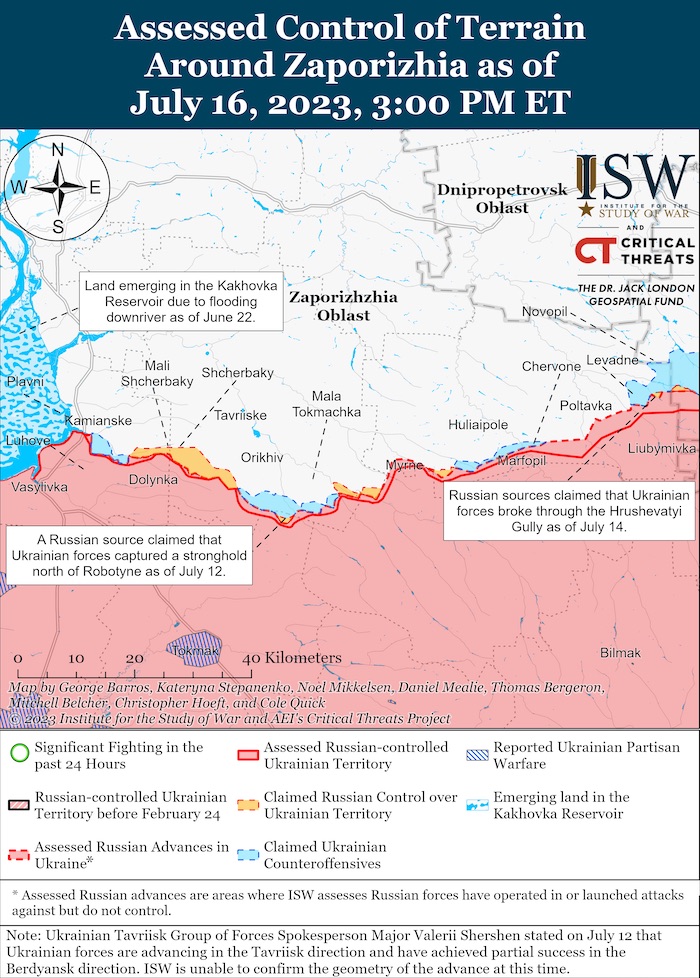
- Zaporizhzhia and Kherson axes: the adversary focuses its main efforts on preventing the further advance of Ukrainian troops. Russian forces launched an airstrike in the vicinity of Mykil’s’ke (Kherson oblast). The invaders shelled more than 25 settlements, including Levadne, Novodarivka, Hulyaipole (Zaporizhzhia oblast), Ivanivka, Kutsurub (Mykolayiv oblast), Dniprovs’ke, Zolota Balka, Molodizhne, Romashkove, Kizomys (Kherson oblast), and the city of Kherson. At the same time, the Ukrainian Defence Forces continue to conduct the offensive operation on Melitopol’ and Berdyans’k axes, consolidating their positions, firing artillery for effect on the identified enemy targets, and conducting counter-battery fire.
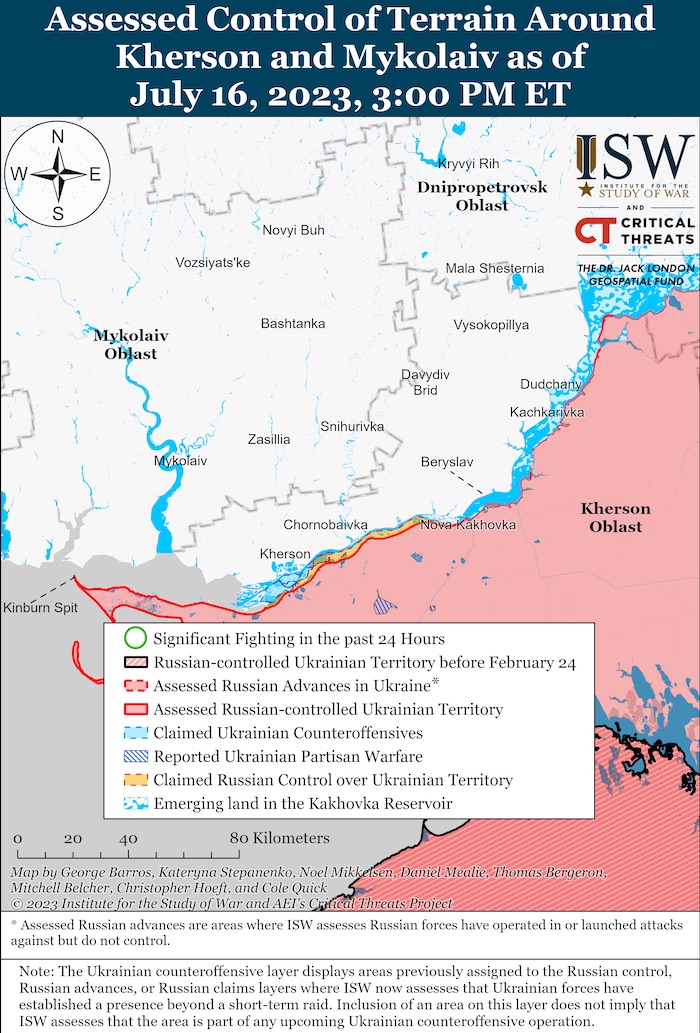
[The enemy continues to use civilian health care facilities in the temporarily occupied territories of Ukraine for their own purposes. In particular, it is known that in t Pokazne, Zaporizhzhia Oblast, the building of the Mykhailiv psycho-neurological boarding school, about 200 patients were taken to an unknown destination, and the service personnel were dismissed. A military hospital for the treatment of wounded Russian troops is planned to be located on the territory and the premises.]
On July 15, the Ukrainian Air Force launched 9 airstrikes on the concentrations of enemy troops. Also, On July 15, the Ukrainian defenders intercepted 7 reconnaissance UAVs.
On July 15, the Ukrainian missile and artillery troops hit 2 ammunition depots, 5 artillery systems at their firing positions, 4 concentrations of troops, 4 electronic warfare stations, 2 air defence systems, and 3 other important targets of the adversary.“
Military Updates
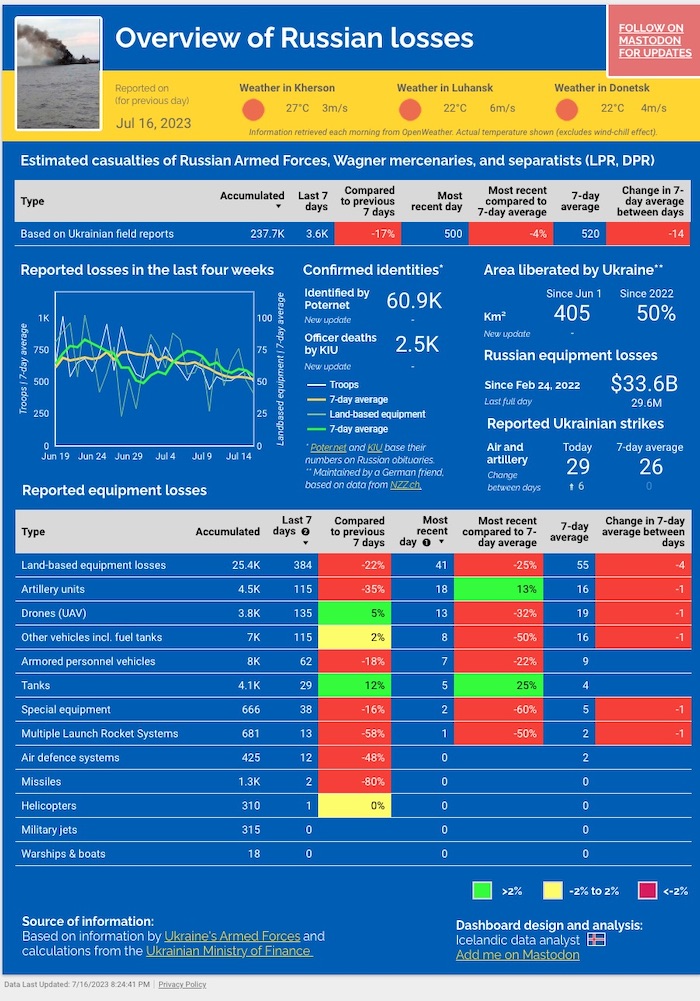
Russians lost almost two companies, six units of military equipment, Ukrinform reports, citing General Oleksandr Tarnavskyi, the commander of the Tavria Operational-Strategic Group of Troops. “In the past 24 hours, the enemy attacked Ukrainian positions 16 times and launched 536 strikes in the Tavria direction. Artillery units of the Defence Forces completed 1,296 fire missions," the report says.
Over the past day, the enemy lost more than two companies of soldiers killed and wounded. Ukrainian defenders destroyed six units of Russian military equipment, including two anti-aircraft missiles, one Murom-M long-range visual surveillance systems, one Pole-21 electronic surveillance system, and vehicles. In addition, three enemy ammunition depots were destroyed.”
In Kherson Oblast, partisans blow up two trucks with Russians inside, Ukrainska Pravda reports. “Ukrainian partisans announced that on 14 July, they conducted a successful operation in the village of Velyki Kopani, located in the temporarily occupied territory of Kherson Oblast.
On 14 July 2023, at 12:00, an agent of the ATESH movement set off an explosion at the occupiers' truck parking lot in the village of Velyki Kopani, Kherson Oblast. The parking lot was located opposite the abandoned Ukrnafta gas station at 34 Lenin Street. As a result of the detonation, 6 soldiers of the Russian Armed Forces were killed, and 2 trucks transporting them were damaged."
On the night of July 15, 2023, the enemy used six "Shahed" type attack drones from the south to strike, the Ukrainian General Staff reports. “Forces and means of the Air Force destroyed four enemy attack drones "Shahed-136/131" in the south and east of the country.
And during the past day on July 14 (in addition to 16 "Shaheeds" shot down at night), air defenses destroyed three reconnaissance UAVs of the operational-tactical level ("Orlan", "Zala") and three attack drones of the "Lancet" type.”
Russia says shot down nine Ukraine drones over Crimea's Sevastopol, Reuters reports. “Russia's air defence forces and fleet in the Black Sea intercepted nine Ukrainian drones over the Crimean port of Sevastopol early on Sunday, a Moscow-installed official said. No objects, either in the city or in the water area were damaged, Mikhail Razvozhayev, the Moscow-installed governor of Sevastopol, said on the Telegram messaging app.
Two aerial drones were shot down over the sea, five were intercepted by Russia's electronic warfare forces and two water surface drones were destroyed on the outer shore, he added. The attacks were over the harbour of Sevastopol and the city's Balaklava, Khersones districts, Razvozhayev said earlier.”
According to British Defence Intelligence, (last 48 hours):
- The Russian security apparatus entered a period of confusion and negotiations after Wagner Group’s 24 June 2023 mutiny. In recent days, an interim arrangement for the future of the group has started to take shape.
- On 12 July 2023, the Russian MoD announced that Wagner had handed over 2000 pieces of military equipment, including tanks. As of 15 July 2023, at least a small contingent of Wagner fighters have arrived at a camp in Belarus.
- Concurrently, some Wagner-associated social media groups have resumed activity, with a focus on highlighting the group’s activities in Africa. Based on recent announcements by Russian officials, the state is likely prepared to accept Wagner’s aspirations to maintain its extensive presence on the continent.
- Russia has routinely sacked commanders since the start of the invasion of Ukraine, but the removal of the 58th Combined Arms Army’s General-Major Ivan Popov is notable, he was apparently dismissed for voicing concerns rather than for any alleged poor performance.
- In a leaked video intended for his troops, Popov delivered a scathing attack on the Russian MoD leadership, whom he accused of, “hitting us from the rear, viciously beheading the Army at the most difficult and intense moment”.
- Popov’s comments draw attention to serious disaffection many officers likely harbour towards the senior military leadership. The complaints largely echo those made by Wagner Group owner Yevgeny Prigozhin prior to his June 2023 mutiny. Direct criticism from subordinates is likely to become an increasing problem for Defence Minister Sergei Shoigu and Chief of the General Staff General Gerasimov.
Losses of the Russian army
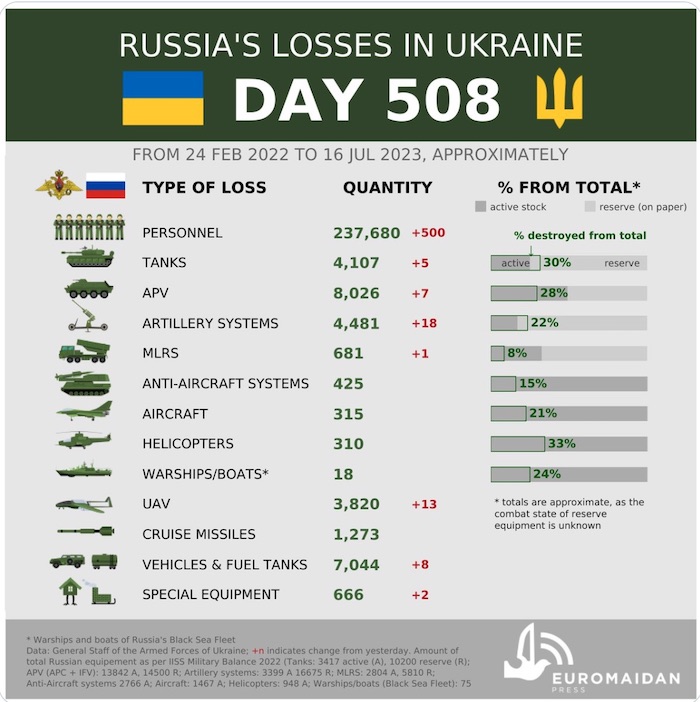
As of Sunday 16 July, the approximate losses of weapons and military equipment of the Russian Armed Forces from the beginning of the invasion to the present day:
- Personnel – about 237680 (+500)
- Tanks – 4107 (+5)
- Armoured combat vehicles – 8026 (+7)
- Artillery systems – 4481 (+18)
- Multiple rocket launchers –MLRS - 681 (+1)
- Air defence means – 425 (+0)
- Aircraft - 315 (+0)
- Helicopters - 310 (+0)
- Automotive technology and fuel tanks – 7044 (+8)
- Vessels/boats - 18 (+0)
- UAV operational and tactical level – 3820 (+13)
- Special equipment – 666 (+2)
- Mobile SRBM system – 4 (+0)
- Cruise missiles – 1273 (+0)
Iran yet to receive Su-35 jets it bought from Russia, Yahoo News reports, citing The New Voice of Ukraine. “Nearly a year after Iran purchased 50 Su-35 fighter jets from Russia, the aircraft are still not delivered, journalist Saeed Azimi wrote in a July 13 report for the Bourse and Bazaar Foundation analytical center. In Azimi's piece, he mentioned that Iranian Brig. Gen. Hamid Vahedi confirmed the completion of all payments for Russia's Su-35 fighters. These jets were expected to be in Tehran's possession this year, yet the government is now uncertain if they will ever arrive. Azimi reported that Iran expected the aircraft to be delivered three weeks ago. […]
According to the report, Iran's air force is primarily composed of antiquated US planes that have far surpassed their operational lifespan. Hence, Tehran was compelled to purchase 50 Su-35 fighters from its ally, Russia.
Russia managed not only to secure the prepayment for the aircraft but also to negotiate a deal for Iranian-made Shahed kamikaze drones. Tehran began supplying the UAVs in late 2022. Nearly a year has passed since these arrangements were made, and yet, Tehran has not received any Su-35 jets.
Azimi's article underscores that Russia, dealing with challenges arising from its full-scale invasion of Ukraine, sought Iran's assistance. In return, Tehran responded to the Kremlin's request, providing support. However, as Azimi concludes, Iran was merely exploited, receiving nothing in exchange.”
Defence forces destroy S-400 Triumf system from which Russians hit pizzeria in Kramatorsk, Ukrinform reports. “The Defense Forces of Ukraine used HIMARS to destroy the Russian S-400 Triumf anti-aircraft missile system located near Debaltseve, Donetsk region.
According to the data available at the Strategic Communications Center, this is the same S-400 system from which a missile was fired at the pizzeria in Kramatorsk, the Operational Command North posted on Telegram.”
Humanitarian
16 high-rise buildings, medical facility and educational institutions damaged in attack on Zaporizhzhia, Ukrainska Pravda reports, citing Anatolii Kurtiev, Secretary of Zaporizhzhia City Council. “A man was injured and an infrastructure facility, 16 high-rise buildings, two educational institutions and a medical facility were damaged in a Russian attack on Zaporizhzhia on the night of 14-15 July.
So far, a total of 174 applications for damaged housing have been received. We are aware of 16 affected high-rise buildings, two educational institutions and one medical facility."
Putin agreed to extension of "grain agreement", - Erdogan (updated), Censor.net reports, citing Hurriyet. “Turkish President Recep Tayyip Erdogan said that Russian dictator Vladimir Putin agreed to extend the "grain agreement" that gives Ukraine the opportunity to export grain through the Black Sea. […] Erdogan also noted that UN Secretary General Antonio Guterres sent a letter to Putin with a proposal to preserve the Black Sea "grain agreement". With this letter, we guarantee the continuation of the grain corridor through the joint efforts of us and Russia. Thus, we will continue to solve the problems of underdeveloped African countries, Erdogan added.
It will be recalled that earlier Putin stated that Russia would support the grain agreement on the condition that Rosselkhozbank joins SWIFT and resolves "some other issues." It is currently unknown whether these conditions will be met, but it has not been reported.
In turn, the Kremlin said that Russia had not made any statements about the continuation of the "grain agreement". We have not made any statements on this matter, said Dmitry Peskov, the press secretary of the Russian president, in a comment to Interfax.”
UN waits for Russian answer as Black Sea grain deal deadline looms, Reuters reports. “United Nations Secretary-General Antonio Guterres is still waiting for a response from Russian President Vladimir Putin on a proposal to extend a deal allowing the safe Black Sea export of Ukraine grain beyond Monday, a UN spokesperson said on Friday.
Guterres wrote to Putin on Tuesday asking him to extend the Black Sea deal in return for connecting a subsidiary of Russia's Agricultural Bank (Rosselkhozbank) to the international payment system SWIFT, sources told Reuters.
The last ship traveling under the Black Sea deal is loading its cargo at Ukraine's Odesa port. Russia has not agreed to register any new ships since June 27 and the initiative will expire on Monday if Moscow does not agree to extend it.”
Environmental
WP: Minefields are big obstacle to Ukraine's counteroffensive, Ukrinform reports, citing The Washington Post. “Russian forces have managed to significantly slow a Ukrainian counteroffensive by mining large areas around their positions. Areas between 5 and 16 kilometres deep in front of the Russians' main strongholds have been densely mined with antitank and antipersonnel mines and trip wires, and this forced the Ukrainian defenders to change their tactics. Rather than try to break through with the infantry fighting vehicles and battle tanks that Western allies provided to aid Ukraine in this counteroffensive, units are moving forward, slowly, on foot, the article reads.
A senior Ukrainian official, who spoke on the condition of anonymity to discuss sensitive military matters, said Kyiv received less than 15 percent of the quantity of demining and engineering materiel that it asked for from Western partners ahead of the counteroffensive. Some of that equipment arrived just last week, the official said. We need special equipment, we need special remote mine-clearance equipment, Commander-in-Chief of the Armed Forces of Ukraine Valerii Zaluzhnyi said. He added that minefields are one of the problems that certainly affects the pace of the offensive. […]
Ukrainian military personnel on the ground also described hesitation to use the larger, more advanced demining equipment. Because, in the Ukrainians' opinion, there are so few of the mine-clearing systems, they have become an easier target for Russian forces, which have prioritized striking them, the article said.
At the same time, the depth and density of the minefields are particular challenges along the southern Zaporizhzhia front line, where the Russians widely expected the Ukrainians to assault. Another challenge for Ukrainian defenders is that the Russians are able to drop more mines from drones, reseeding areas that the Ukrainians had cleared.
Because the Russians have drones in the sky on the lookout for any mine-clearance systems to target with artillery and missiles, the Ukrainians are trying for now to save the few they do have by doing the job manually. Sapper units — sometimes a group of just four people — will often wait for twilight to clear paths, as they are too visible in the daylight and can be seen through night-vision devices in the dark, the article reads.”
Legal
Over 50 Russians found guilty of war crimes in Ukraine – Ukraine's Prosecutor General, Ukrainska Pravda reports, citing Ukraine’s Prosecutor General Andrii Kostin. "Over 300 people (Russians – ed.) have been identified and become suspects. These are not only identified potential Russian criminals but there is evidence that confirms that these people committed a particular crime. Over 200 have been charged, meaning that we have completed the investigation, gathered sufficient evidence and submitted these files to the court. And more than 50 Russians have already been found guilty by Ukrainian courts."
Kostin noted that some might say that 50 sentences are not too much; at the same time, international partners are surprised by such a large number of them and the fact that during the war, Ukraine not only records crimes but also investigates them and brings them to court.
Kostin added that although such trials are held in absentia, having the aggressor's guilt proven is essential for victims. The Prosecutor General said that Ukraine, together with its partners, has been developing strategic documents on how to investigate such cases in order to unify the practice.”
Support
Lithuanian president feared a ''deterioration of NATO decisions'' after Zelenskyy's tweet, Ukrainska Pravda reports, citing President Nausėda in an interview with LRT. “Lithuanian president Gitanas Nausėda said he feared that the decisions made at the NATO summit would deteriorate due to an angry tweet by Ukrainian President Volodymyr Zelenskyy, which was posted on his way to Vilnius. The tension was high, and there was a point where I was afraid NATO’s position could suddenly change for the worse, leaving out issues that are extremely important for us and Ukraine.
He added that he understood Zelenskyy's feelings, but at the same time was aware that we have already reached the maximum of what is possible, and any attempt to go further would destroy the Vilnius summit itself. I say this with complete sincerity. It could have happened, but it didn’t, and that is why we are speaking in a completely different manner today. President Zelenskyy, as you saw, spoke in a completely different tone the following day. […]
On his way to Vilnius for the NATO summit, Zelenskyy tweeted that there was currently no readiness among the allies to invite Ukraine to NATO or make it a member. According to media reports, this was an attempt by the Ukrainian delegation to influence the course of discussions within NATO, but it backfired. The US was particularly irritated, as it had not been warned about the social media post, forcing the British delegation and part of the German delegation to intervene.”
Ukraine's invitation to NATO tied to end of war – Lithuanian President, Ukrainska Pravda reports, citing LRT. “Lithuanian President Gitanas Nausėda has said that Ukraine's invitation to NATO is mainly linked to the war's end. According to Nausėda, no one in NATO is now wondering whether Ukraine will become a member of NATO. Many decisions have been made that primarily strengthen our security and strength, he said.
The Lithuanian President noted that Ukraine and President Volodymyr Zelenskyy know the conditions for joining NATO, but they fear their list could be endless. They are afraid of the wording. Based on the fact that ‘if the conditions are met’, more and more new requirements can be put forward, Nausėda added. He said that he assured Zelenskyy that everyone in NATO supports Ukraine.
The decision of the Vilnius summit contains quite positive wording regarding Ukraine. In particular, the NATO summit agreed to remove the requirement for an action plan for membership on Ukraine's way to the Alliance. At the same time, the allies made it clear that they would invite Ukraine to join NATO "when the conditions are met." The summit's decision does not include a list of conditions that Ukraine must fulfil. But, according to the European Pravda, there will also be political ones among them, i.e. ones related to reforms.”
European countries are still waiting for US permission to train Ukrainian pilots on F-16s, Ukrainska Pravda reports, citing Politico. “A coalition of European countries that this week promised to begin training Ukrainian pilots on F-16 fighter jets is still waiting for official US approval of the programme. Official training can begin only after the US State Department officially signs off on a request for the transfer of instructions, flight simulators and other materials related to the aircraft, which has not yet happened.
The formal request "is still being reviewed," according to Lieutenant Colonel Garron Garn, the representative of the Pentagon, who referred additional inquiries to the State Department despite President Joe Biden's pledge to approve the programme. A representative for the State Department declined to comment. There is no indication that the US will disapprove of the programme, but requests from the Europeans have been pending for several weeks.
This week, Ukraine signed a memorandum with its 11 partner states at the NATO Summit in Vilnius. The memorandum defines the training conditions of Ukrainian pilots on the F-16 fighter jets.”
South Korea to increase military and humanitarian aid to Ukraine, Ukrainska Pravda reports, citing Interfax-Ukraine, citing Yeol at a briefing after talks with President Volodymyr Zelenskyy on Saturday in Kyiv. “South Korean President Yoon Suk Yeol has said that the Republic of Korea will increase the amount of military and humanitarian aid provided to Ukraine in 2023. We provided bulletproof vests, helmets, and other necessary ammunition last year. We hope that this year the level of our assistance will be much greater...
President Zelenskyy and I agreed in May on the supply of the necessary equipment for such purposes as, for example, humanitarian mine clearance, and we continue to do so. Last year, the Korean government allocated USD$100 million to support Ukraine. This year, this support will amount to USD$150 million. […] The president also emphasised that the Peace Formula must be implemented.”
18,000 Ukrainian infantrymen have completed training in UK, Ukrainska Pravda reports, citing UK Ministry of Defence. “The UK Ministry of Defence posted a video on 15 July showing some of the training. Op Interflex, the UK-led infantry training of Ukrainian volunteers, has so far trained 18,000 recruits. Op Interflex teaches Ukrainians how to survive and be lethal in their fight against the illegal invasion of their homeland.
The Defence Ministry recalled that Op Interflex was launched at the end of June 2022.”
New Developments
- India, together with France, will prepare plan to end Russian-Ukrainian war, - Le Monde, net reports, citing Le Monde. “India wants to develop its peace plan together with France to settle Russia’s war against Ukraine. It is noted that the plan will differ from previously proposed initiatives. […] The Indian Prime Minister emphasized that he is in favor of a diplomatic solution to the conflict, but did not confirm that he wants to act as a mediator. According to the French newspaper, after the meeting with Macron, Modi instructed his subordinates to develop a peace plan for Ukraine together with France in order to get out of the "diplomatic corner". The publication emphasizes that we are talking about initiatives that will differ from the proposals put forward by China and the "Global South", that is, the countries of Latin America, Africa and Asia.”
- Zelenskyy says quick end to war directly depends on global support, Ukrainska Pravda “Now, when the speed of ending the war directly depends on global support for Ukraine, we are doing everything possible to ensure that such support is as intensive and meaningful as possible. […] The president also emphasised that Ukraine cannot leave any of our people, any towns and villages under Russian occupation".
- UK Defence Minister Wallace considers resigning, Ukrainska Pravda reports, citing The Times. “Ben Wallace, Secretary of State for Defence of the United Kingdom, is considering the possibility of leaving his government and resigning, the media write. UK Prime Minister Rishi Sunak is said to be preparing to reshuffle his team in the autumn in an attempt to reboot the government ahead of the next election. The newspaper writes Wallace believes that his time as defence secretary is ending, and he is considering the possibility of leaving the government. One of the reasons, the publication cites, is that the UK Prime Minister failed to convince US President Joe Biden and other leaders that Wallace should become the next Secretary General of NATO. […] The media emphasises that Wallace is considering a full retirement from politics.”
China's Wang Yi urges EU to 'clarify' its position on partnership, Reuters reports. “The European Union must further "clarify" its position on its strategic partnership with Beijing, China's top diplomat Wang Yi told European Union foreign policy chief Josep Borrell, as EU leaders called for reduced dependence on China. The launch of an EU-China comprehensive strategic partnership in 2003 had promised to elevate ties beyond trade and investment. But since 2019, the 27-nation bloc has called China an "economic competitor" and a "systemic rival", with Beijing's close relations with Moscow after Russia's invasion of Ukraine increasing the caution. […] Last month, EU leaders committed to lessening the area's dependence on China and debated how to strike a balance between "de-risking" and cooperating in areas such as climate change. In March, European Commission President Ursula von der Leyen said a hardening of China's position required Europe to "de-risk" both economically and diplomatically.”
Assessment
- On the war.
The Institute for the Study of War has made the following assessment as of July 15, 2022:
Russian forces conducted offensive operations and made limited territorial gains near Svatove on July 15. Geolocated footage published on July 15 shows that unspecified Russian infantry advanced slightly in Novoselivske (16km northwest of Svatove) and hold entrenched positions along the railroad near the settlement. The Ukrainian General Staff reported that Russian forces conducted unsuccessful offensive operations south of Novoselivske. A Kremlin-affiliated milblogger reported that Russian forces are also trying to seize a tactical height near Novoselivske and clear Ukrainian forces from the forests south of the settlement. The milblogger claimed that neither Russian nor Ukrainian forces control Novoselivske and that movement in the settlement is difficult due to a lack of shelter and Ukrainian drone activity. The milblogger also claimed that Russian artillery elements of the 21st Separate Guards Motorized Rifle Brigade (2nd Combined Arms Army, Central Military District) stopped a Ukrainian attack near Kuzemivka (16km northwest of Svatove). Ukrainian Eastern Group of Forces Spokesperson Colonel Serhiy Cherevaty reported that Russian forces are most active in the Kupiansk and Lyman directions.
A Russian source claimed that Ukrainian forces conducted offensive operations near Kreminna and did not make any advances in the area on July 15. A Kremlin-affiliated milblogger claimed that a Ukrainian sabotage and reconnaissance group attempted to break through Russian defensive lines towards Dibrova (6km southwest of Kreminna) from the Serebryanske forest area (10km south of Kreminna). The milblogger also claimed that Ukrainian forces continued offensive operations in the forests west of Kreminna.
Russian forces conducted offensive operations near Kreminna and reportedly made limited territorial gains on July 15. The Ukrainian General Staff and Cherevaty reported that Russian forces conducted unsuccessful offensive operations east of Novosadove (17km northwest of Kreminna), west of Dibrova, and east of Vesele (30km south of Kreminna) . […] A Russian milblogger claimed that Russian forces advanced near Torske and in the forests near Kreminna. A Kremlin-affiliated milblogger claimed that Russian forces advanced towards Yampolivka (17km west of Kreminna) but that there is currently no reliable information on the control of terrain around Torske. […]
Ukrainian forces reportedly made limited territorial gains on Bakhmut’s southern flank, as positional battles continued elsewhere along the Bakhmut frontline on July 15. A Kremlin-affiliated milblogger claimed that Ukrainian forces advanced near Andriivka (10km south of Bakhmut) and crossed the Siverskyi Donets-Donbas Canal in the area. Another Russian source claimed that Ukrainian forces advanced in the Kurdyumivka (15km southwest of Bakhmut) direction. […] Russian sources claimed that Ukrainian forces continued to attack Russian positions near Klishchiivka (7km southwest of Bakhmut) and unsuccessfully attempted to regain positions in the Berkhivka (6km north of Bakhmut) area. The milbloger noted that the situation largely did not change in the Berkhivka and Rozdolivka (16km northeast of Bakhmut) areas, and several Russian milbloggers claimed that intense battles are ongoing in the Klishchiivka area. Ukrainian Eastern Group of Forces Spokesperson Colonel Serhiy Cherevaty observed that Ukrainian forces maintain the initiative on the Bakhmut frontline.
Russian sources claimed that Russian forces made limited advances on Bakhmut’s northern and southern flanks and continued to respond to Ukrainian counteroffensives by committing elite units to defend Bakhmut’s flanks on July 15. A Kremlin-affiliated milblogger claimed that Russian forces successfully counterattacked west and northwest of Klishchiivka and recaptured 500 meters of territory. The Ukrainian General Staff reported that Russian forces unsuccessfully launched assaults southwest of Andriivka and in the Berkhivka area. A Kremlin-affiliated milblogger claimed that Russian forces unsuccessfully counterattacked near Berkhivka, and Ukrainian forces were able to retain their positions. A Russian milblogger claimed that Russian forces are constantly sending reinforcements to defend against Ukrainian attacks and have transferred an unspecified BARS (Russian Combat Army Reserve) unit from the Kreminna area to Klishchiivka. Chechen Republic Head Ramzan Kadyrov claimed that elements of the Chechen ”Akhmat” Spetsnaz unit, 364th Special Purpose Brigade, and 4th Motorized Rifle Brigade (2nd Luhansk People’s Republic Army Corps) are operating in the Klishchiivka area. A Russian milblogger indicated that elements of the 364th Special Purpose Brigade are involved in repelling Ukrainian counteroffensives near Klishchiivka. A Kremlin-affiliated milblogger also noted that elements of the Russian 98th Guards Airborne (VDV) Division advanced south of the Berkhivka reservoir on July 13. Russian commitment of numerous VDV and Spetsnaz units north and south of Bakhmut indicates that Ukrainian counteroffensives in the Bakhmut direction are continuing to trigger the deployment of further reinforcements, predominantly from the Luhansk frontline.
Russian forces continued limited offensive operations on the Donetsk City-Avdiivka line but did not make any territorial gains on July 15. The Ukrainian General Staff reported that Russian forces conducted unsuccessful offensive operations in the Pervomaiske (11km west of Avdiivka), Marinka (23km southwest of Donetsk City), and Novomykhailivka (29km southwest of Donetsk City) areas. A Russian news aggregator claimed that Russian forces attacked Ukrainian positions near Novokalynove (12km north of Avdiivka) and southwest of Avdiivka, while positional battles continued in Marinka. A Kremlin-affiliated milblogger claimed that Russian forces conducted unsuccessful attacks on Novomykhaivlivka, Marinka, and Pervomaiske.
Ukrainian forces continued counteroffensive operations along the western Donetsk-eastern Zaporizha Oblast border and reportedly made limited gains on July 15. A Kremlin-affiliated milblogger claimed that Ukrainian forces gained a foothold near Hrusheva Gully (just south of Rivnopil). […] Russian milbloggers claimed that Ukrainian forces conducted attacks northwest of Staromayorske (9km south of Velyka Novosilka) and near Pryyutne (15km southwest of Velyka Novosilka). A milblogger claimed on July 14 that Ukrainian forces conducted attacks near Novodonetske (12km southeast of Velyka Novosilka), Urozhaine, Pryyutne, and Staromayorske. […]
Ukrainian forces continued counteroffensive operations and reportedly made limited advances in western Zaporizhzhia Oblast on July 15. Russian milbloggers claimed that Ukrainian forces made limited advances northeast of Robotyne (12km south of Orikhiv). […] A Russian milblogger claimed on July 14 that elements of the 429th Motorized Rifle Regiment (19th Motorized Rifle Division, 58th Combined Arms Army, Southern Military District) repelled Ukrainian attacks near Pyatykhatky-Zherebyanky (up to 27km southwest of Orikhiv). […]
Ukrainian forces continue their interdiction campaign in southern Ukraine. Geolocated footage published on July 14 shows a Ukrainian strike on naval infantry elements of the Caspian Flotilla moving in a convoy northwest of Tokmak. Russian sources claimed that Ukrainian forces conducted a missile strike near a railway bridge near Chernihivka in Zaporizhzhia Oblast.
Russian sources claimed that Ukrainian forces continue to operate on east (left) bank Kherson Oblast near the Antonivsky Bridge and did not claim any Russian or Ukrainian advances in the area. Kherson Oblast Occupation Head Vladimir Saldo claimed that Ukrainian forces continue to hold positions near the Antonivsky Bridge and that Russian forces repel all Ukrainian attempts to cross the Dnipro River. A Kremlin-affiliated milblogger claimed that Russian forces repelled five of six small Ukrainian boats from landing on the east bank of the Dnipro River.
Russian sources reported on July 15 that the Russian military command dismissed 106th Guards Airborne (VDV) Division Commander Major General Vladimir Seliverstov. Russian sources stated that the reason for Seliverstov’s dismissal is currently unknown but speculated that it could be associated with Seliverstov’s reputation for speaking up on behalf of his soldiers. Russian sources claimed that the 106th VDV Division has been operating in the Bakhmut area since January, and ISW has recently observed the 106th VDV Division’s 137th Guards VDV Regiment defending against Ukrainian counteroffensive operations on Bakhmut’s northern flank. A Russian milblogger has claimed that elements of the 106th VDV Division are also supporting Russian defensive operations south of Bakhmut. Relatives of mobilized personnel serving in the 137th VDV Regiment notably appealed to Russian President Vladimir Putin, Tula Oblast Governor Alexei Dyumin, and Russian Defense Minister Sergei Shoigu in April about poor conditions and lack of supplies in the unit. Vocal discontent about conditions in areas where Russian forces are defending against Ukrainian counteroffensive operations may have prompted Seliverstov to appeal to the Russian military command, which may have contributed to his dismissal. ISW has not observed confirmation of Seliverstov’s dismissal, but Russian reporting about the dismissal follows a pattern similar to that of previous claims of command changes that have proven true.
Seliverstov’s dismissal may be a part of an ongoing purge of insubordinate commanders by the Russian military command and may suggest that the corrosion of the Russian chain of command in Ukraine is accelerating. The Russian military command recently dismissed 58th Combined Arms Army (Southern Military District) Commander Major General Ivan Popov after he reportedly attempted to bypass Chief of the Russian General Staff and overall theater commander Army General Valery Gerasimov and bring his complaints about the situation in western Zaporizhzhia Oblast directly to Putin. Popov’s complaints reportedly centered on a lack of rotations for his troops, and in a leaked audio message Popov also complained about heavy losses and a lack of effective counterbattery capabilities. These issues are likely impacting Russian forces throughout the theater in Ukraine, and reports of Seliverstov’s dismissal only four days after reports of Popov’s dismissal suggest that the Russian command may have fired Seliverstov for similar reasons. ISW assessed that Popov’s insubordination is indicative of a pattern of behavior that has developed within the Russian command in Ukraine, in which commanders have challenged the authority of senior commanders and sought to use their responsibility for key sectors of the front to cajole the Kremlin to support them.
Endemic problems within the Russian war effort in Ukraine, exacerbated by poor decisions made by senior political and military leaders, are likely prompting strong-willed commanders to challenge their senior commanders in efforts to preserve their forces and lead combat effective units. The 58th Combined Arms Army‘s (CAA) and the 106th VDV Division’s relatively effective defense against Ukrainian counteroffensive operations in their respective areas of the front thus far suggests that they are some of the most combat effective formations committed to the frontline, and Popov and Seliverstov likely contributed to their relative effectiveness by being willing to challenge superiors and the system. Popov’s reported actions clearly crossed the line to insubordination. Seliverstov may have followed Popov’s example or the Russian military leadership may have dismissed Seliverstov out of the fear that he would do so.
Seliverstov’s dismissal suggests that there is a deep concern within the Russian military leadership about the chain of command in Ukraine. Popov’s, Russian VDV Commander Colonel General Mikhail Teplinsky’s, and Wagner Group financier Yevgeny Prigozhin’s challenges to Gerasimov’s and Shoigu’s authority have established a precedent for insubordination that can hollow out support for the Russian military command among senior officers. ”Vostok“ Battalion Commander Alexander Khodakovsky, who leads forces defending against Ukrainian counteroffensives in western Donetsk Oblast, amplified Popov’s complaints about the lack of Russian counterbattery capabilities on July 15, suggesting that the controversy with Popov’s dismissal may be influencing other commanders to more publicly voice their frustrations. The apparently intensifying pattern of insubordination may prompt the Russian military leadership to replace commanders whom they perceive to be potentially insubordinate with loyal figures, preferring yes-men to competent and strong-willed officers able to maintain the combat capabilities of Russian formations defending in key sectors of the front in Ukraine.
The Russian military leadership is likely attempting to dissuade commanders from emulating recent cases of insubordination by punishing those involved in leaking Popov’s message of complaints. Shoigu is also likely attempting to mitigate the aftermath of Popov’s leaked audio recording within the Russian government and punish Russian State Duma Deputy and former Deputy Commander of the Southern Military District (SMD) Lieutenant General Andrei Gurulev for the leak. Russian sources speculated that Shoigu is demanding that the Russian State Duma Defense Committee expel Gurulev for leaking Popov’s audio message. A Russian source close to Russian security officials claimed that the United Russia party is preparing a set of punishments that will include censoring Gurulev from discussing Russia’s invasion of Ukraine. One source claimed that Gurulev’s fate in the State Duma depends on an upcoming meeting between Secretary of the General Council of United Russia Party Andrey Turchak and Shoigu. Turchak previously publicly accused Gurulev of leaking the audio recording to stage a ”political show.” Another source claimed that Gurlev was summoned to meet with Chairman of the Russian State Duma Vyacheslav Volodin on July 17.
Growing insubordination will likely exacerbate existing factional divides within the Russian military and the wider Russian security sphere. A Russian source claimed that Dyumin unsuccessfully attempted to intercede to prevent Seliverstov’s dismissal in a trip to Moscow on July 14. Dyumin may have been advocating for Seliverstov in opposition to Shoigu and Gerasimov or simply because the 106th VDV Division is headquartered in Tula Oblast. In either case Dyumin‘s intervention likely inflamed perceptions within the Russian military that the dismissal was associated with factionalism. Gerasimov and Shoigu may view Dyumin as an anti-MoD establishment figure due to his reported affiliations with Prigozhin, his reported involvement in negotiations that brought Wagner’s rebellion to an end, and widespread rumors following the rebellion that Dyumin would replace Shoigu as defense minister. Shoigu and Gerasimov may also view insubordination within the VDV as the result of factionalism since Teplinsky is now the highest profile anti-Gerasimov officer following Prigozhin’s apparent denouement. Russian sources notably claimed that the 106th VDV Division closely operated alongside Wagner forces in January 2023 as their offensive on Bakhmut intensified, and Gerasimov and his affiliates may view Seliverstov as an officer in a hostile camp due to his relationships with both Wagner and Teplinsky. Russian forces also claimed that Seliverstov routinely opposed the command of former VDV commander and close Gerasimov affiliate Colonel General Andrey Serdyukov during the Russian offensive on Kyiv in the early stages of the full-scale invasion and may have established himself as a noted anti-Gerasimov commander at that time, since Serdyukov was in Gerasimov’s patronage. Teplinsky’s and Prigozhin’s challenges to Gerasimov and Shoigu likely engendered a view within the MoD establishment that acts of insubordination are likely also factional power plays aimed at weakening their support with the Kremlin. Gerasimov and Shoigu may increasingly view opposition to their decisions as evidence of factionalism and may use perceived factional affiliations as grounds for punishing or firing those they view as presenting a threat of insubordination. […]
Ukrainian forces conducted counteroffensive operations on at least three sectors of the front on June 15 and reportedly made limited gains. Russian sources claimed that Ukrainian forces made limited gains south of Bakhmut near Andriivka (10km south of Bakhmut) and crossed the Siverskyi Donetsk Canal in the area. Russian sources also claimed that Ukrainian forces made limited advances in the western Donetsk-eastern Zaporizhzhia Oblast border area southwest of Velyka Novosilka and in western Zaporizhzhia Oblast northeast of Robotyne (12km south of Orikhiv). A Russian milblogger claimed that Russian forces are ”constantly” moving reinforcements to the Bakhmut area and recently transferred an unspecified BARS (Russian Combat Reserve) unit from the Kreminna area to near Klishchiivka (7km southwest of Bakhmut), indicating that Ukrainian counteroffensive operations continue to trigger transfers of Russian forces to the Bakhmut area. Ukrainian Tavriisk Group of Forces Commander Brigadier General Oleksandr Tarnavskyi stated in an interview with CNN published on July 14 that the counteroffensive is successful but acknowledged that the tempo of Ukrainian advances is slower than expected. Tarnavskyi stated that Ukrainian forces are effectively defeating Russian forces at longer distances, likely referencing Ukraine’s continued interdiction campaigns in eastern and southern Ukraine. Tarnavskyi also reported that Ukrainian forces received cluster munitions that can ”radically change [the battlefield]” and have yet to use them.
The New York Times (NYT) reported that the Ukrainian military has adjusted its strategy to minimize Ukrainian casualties while continuing to attrit Russian forces, supporting ISW’s previous assessments. NYT reported that unnamed US and European officials estimated that Russian forces destroyed up to 20 percent of Ukraine’s Western-provided weaponry in the first two weeks of the counteroffensive. The NYT reported that officials stated that the rate of losses has dropped to 10 percent in the subsequent weeks due to a change in Ukrainian strategy. The NYT reported that the Ukrainian military has changed tactics to focus on wearing down Russian forces with artillery and long-range missiles instead of large-scale assaults, which is consistent with Ukrainian Commander-in-Chief General Valerii Zaluzhnyi’s statement on July 14 that increased Ukrainian indirect fire can both pin down Russian forces and minimize Ukrainian casualties. ISW previously assessed on July 4 that Ukrainian forces appear to be focusing on creating an asymmetrical attrition gradient that conserves Ukrainian manpower at the cost of a slower rate of territorial gains, while gradually wearing down Russian manpower and equipment. Ukraine‘s military has likely been refining its counter-offensive strategy for weeks, and the larger effects of those adjustments are only just becoming clear to some observers. Ukraine will likely continue to adjust its strategy and execution throughout the counteroffensive to facilitate continued progress. […]
Russian authorities likely continue to forcibly integrate Ukrainian Orthodox Church (UOC) dioceses into the Kremlin-controlled Russian Orthodox Church (ROC) as part of a wider religious persecution campaign in occupied Ukraine. Luhansk People's Republic (LNR) Head Leonid Pasechnik announced on July 15 the incorporation of the Luhansk, Alchevsk, Sievierodonetsk, Starobilsk, and Rovenky UOC dioceses into the ROC. The ROC has already seized the Berdiansk and Prymorsk dioceses in occupied Zaporizhzhia Oblast, and a Russian news aggregator claimed that the Russian Ministry of Justice recently registered the Donetsk City and Horlivka dioceses as part of the ROC. The new round of forced integration of the UOC dioceses in occupied Luhansk Oblast followed a Ukrainian court ruling that the Head of the Kyiv-Pechersk Lavra Metropolitan Pavel will go to a detention center instead of remaining under house arrest. Russian sources attempted to portray the integration of UOC dioceses into the ROC as a response to claimed Ukrainian religious suppression of a Kremlin-run ROC. The ROC has explicit links to the Kremlin and has provided material and spiritual support to Russia during the war. This explanation makes little sense, however, as the ROC clearly faces no threats from the Ukrainian government in Russian-occupied territory. The Ukrainian government is not engaging in religious suppression, moreover, but rather acting against religious elements it asserts are linked to the Kremlin’s war effort. Russian authorities have conducted systematic religious persecution in occupied Ukraine since the start of the war, however.
Key Takeaways:
- Russian sources reported on July 15 that the Russian military command dismissed 106th Guards Airborne (VDV) Division Commander Major General Vladimir Seliverstov.
- Seliverstov’s dismissal may be a part of an ongoing purge of insubordinate commanders by the Russian military command and may suggest that the corrosion of the Russian chain of command in Ukraine is accelerating.
- The Russian military leadership is likely attempting to dissuade commanders from emulating recent cases of insubordination by punishing those involved in leaking Popov’s message of complaints.
- Growing insubordination will likely exacerbate existing factional divides within the Russian military and the wider Russian security sphere.
- Factions within the Russian security forces and the Kremlin appear to be fighting for control over the Russian insider information space.
- Polyakov’s arrest suggests that different factions within the Kremlin and Russian security entities are exploiting the Russian information space and secret information to advance their political and financial objectives against the backdrop of Russia’s war in Ukraine.
- Ukrainian forces conducted counteroffensive operations on at least three sectors of the front on June 15 and reportedly made limited gains.
- The New York Times (NYT) reported that the Ukrainian military has adjusted its strategy to minimize Ukrainian casualties while continuing to attrit Russian forces, supporting ISW’s previous assessments.
- The Belarusian Ministry of Defense (MoD) announced that it developed a plan for Wagner Group personnel to train Belarusian forces as Ukrainian, Russian, and Belarusian sources continue to report that Wagner forces are moving to Belarus.
- Russian authorities likely continue to forcibly integrate Ukrainian Orthodox Church (UOC) dioceses into the Kremlin-controlled Russian Orthodox Church (ROC) as part of a wider religious persecution campaign in occupied Ukraine.
- Russian forces conducted offensive operations and made limited territorial gains near Svatove.
- Ukrainian forces reportedly made limited territorial gains on Bakhmut’s southern flank, while Russian sources claimed that Russian forces made limited advances on Bakhmut’s northern and southern flanks.
- Ukrainian forces continued counteroffensive operations along the western Donetsk-eastern Zaporizhzhia Oblast border and reportedly made limited gains.
- Russian forces continued limited offensive operations on the Donetsk City-Avdiivka line but did not make any territorial gains.
- Ukrainian forces continued counteroffensive operations and reportedly made limited advances in western Zaporizhzhia Oblast.
- The Russian Ministry of Defense (MoD) announced the completion of Russia’s spring 2023 conscription cycle on July 15.
- The Ukrainian Resistance Center reported that the Kremlin launched a program to recruit young adults in Russia for service in occupation administrations in Ukraine.
Zaluzhny: In a war, enemy can and should be killed on its territory. If our partners are afraid to use their weapons, we will kill with ours, Censor.net reports, citing the Commander-in-Chief of the Armed Forces of Ukraine Valeriy Zaluzhny in an interview with The Washington Post. “If partners are afraid to provide Ukraine with weapons that could be used to strike at the territory of the aggressor country, Russia, Ukraine will use weapons of its own production.
WP writes that the General is forced to achieve success on the battlefield in a situation where Ukraine's ammunition supplies are limited, and Russian occupiers often fire three times as many shells per day, modern Western fighters will not appear on the battlefield until next year, and Western allies do not want Ukraine to use long-range missiles and other weapons to strike Russian territory for fear of "escalation." Therefore, Zaluzhny uses Ukrainian-made weapons, the article says.
In order to save my people, why should I ask someone's permission to do something on enemy territory? For some reason, I have to think that I can't do anything there. Why? Because Putin... will use nuclear weapons? Children who are dying don't care. This is our problem, and it is up to us to decide how to kill this enemy. In a war on its territory, we can and should kill. If our partners are afraid to use their weapons, we will kill with ours. But only as many as necessary, he emphasized.»
Zaluzhny about de-occupation of Crimea and allies’ fears about Putin’s reaction: I don’t care. As soon as I have means, I will do something, Censor.net reports. “Ukrainian Armed Forces Commander-in-Chief Valeriy Zaluzhnyi promises to liberate Crimea from Russian troops, even if some Western allies do not support the de-occupation of the peninsula.
According to the publication The Washington Post, Some Western officials privately worry about what Russian dictator Vladimir Putin's reaction would be if Ukrainian troops ever reached Crimea. As soon as I have the means, I will do something. I don't care - no one will stop me, Zaluzhny said in a commentary to the publication.”
Ukraine changes its counteroffensive tactics after heavy equipment losses – NYT, Ukrainska Pravda reports, citing The New York Times. “Ukrainian troops have changed the tactics of conducting a counteroffensive, which helped them reduce losses in military equipment but also slowed down the territories’ liberation. According to The New York Times, up to 20% of the military equipment delivered to the front line, including Western models, was damaged or destroyed in the first two weeks of the counteroffensive.
This level of equipment losses decreased to 10% in the following weeks due to the fact that Ukraine had changed its counteroffensive tactics. In particular, Ukraine’s Armed Forces are focused more on exhausting Russian forces with artillery and long-range missiles than on attacking Russian-mined fields, The New York Times wrote.
But that good news obscures some grim realities. The losses have also slowed because the counteroffensive itself has slowed – and even halted in places – as Ukrainian soldiers struggle against Russia’s formidable defences. And despite the losses, the Ukrainians have so far taken just five of the 60 miles [8 kilometres from 96 – ed.] they hope to cover to reach the sea in the south and split the Russian forces in two.
The New York Times cites military experts who say that the first 25km of the counterattack will be the most difficult, as attacking troops typically need three times as many forces, including weapons, personnel or both, as those defending.”
Large convoy of Wagner PMC fighters arrives in Belarus, Ukrainska Pravda reports, citing Belaruski Hajun, an independent Belarusian military monitoring media outlet. “On the morning of 15 July, Belarusian activists reported that a large convoy of cars and trucks with the licence plates of the so-called "DNR/LNR" with the Wagner PMC fighters inside arrived in Belarus. The set of factors indicates that this is a convoy of the Wagner military command centre that entered Belarus from the Russian Federation in the Krychaw area at night.
Then they proceeded through Rahachow toward Babruysk and then to Asipovichy. The route indicates that the Wagner group convoy is moving to the tent camp in the village of Tsel. According to the volunteers, at least 60 vehicles were seen in the convoy, including pick-up trucks, large trucks, loaves and at least three buses for transporting people. It is noted that the Belarusian police accompanied the convoy.”
Wagnerites in Belarus: Ukrainian border guards track movements of Russian mercenaries, Ukrainska Pravda reports, citing Andrii Demchenko, Speaker for the State Border Guard Service of Ukraine. “The State Border Guard Service of Ukraine confirms the presence of separate groups of Wagner Private Military Company (PMC) in Belarus, and Ukrainian law enforcement officers will closely monitor their steps on the territory of this country.
As we reported earlier, given the statements and rhetoric of the Belarusian leadership regarding the reception of Russian mercenaries and the arrangement of places for their deployment, it was impossible to exclude that sooner or later they would appear in Belarus. Currently, available information shows that separate groups of representatives from private military campaigns moving from the territory of Russia have begun to be observed in Belarus.
In turn, we continue to monitor this situation to understand all the places where they will be deployed, how many of them there will be, and what tasks they will perform."
Wagner Group expands its influence in Belarus with Lukashenka's support, Ukrainska Pravda reports, citing the National Resistance Center. “The National Resistance Center has reported that the Wagner Private Military Company (PMC) continues "occupying Belarus", enjoying the support from dictator Aliaksandr Lukashenka.
Information received from the Belarusian underground says that the Wagner PMC is expanding its sphere of influence in Belarus, receiving full support from the current autocratic regime of Aleksander Lukashenka. Ukraine's Special Operations Forces has confirmed the arrival of about 240 people, 40 trucks and a large amount of weapons in Asipovichy, Mogilev Oblast. The National Resistance Center noted that the group’s quarters are located 20 kilometres from Asipovichy.”
UK Defence Secretary explains why he considers Russia grave threat in coming years, Ukrainska Pravda reports, citing The Times. “UK Defence Secretary Ben Wallace believes Russia will remain a serious threat in the future and is most concerned about the risk of a direct clash with Russia, accidentally or otherwise. Wallace stated his grave concern over the growing threat from China and its intentions towards Taiwan, as well as the threats from the global activities of terrorist organisations such as al-Qaeda and ISIS.
However, Wallace is most concerned about the threat of a military conflict with Russia, whether by accident or otherwise. He believes Russia remains a severe force even after its losses in Ukraine. If Putin loses in Ukraine, he will be deeply wounded…He's still got an air force and he's still got a navy — and we see his navy do quite aggressive manoeuvres… There is an ability for him, in the next three or four years, to lash out, Ben Wallace pointed out, also noting that Russia still has nuclear weapons.
He added that Putin was not done yet and would be looking for those responsible for his troubles and that Russia had already voiced speculation that the UK might have been involved in Prigozhin's rebellion. Ben Wallace mentioned that Russia could potentially attack allies' underwater communications, which provide data and power. 40 per cent of Europe's energy now comes from Norwegian gas fields. We had a clear identifiable vulnerability, the secretary stressed.”
- Consequences and what to do?
West seeks to contain Russian influence as tensions rise over Ukraine, New Voice of Ukraine reports. “Diplomat and international expert Ruslan Osypenko has cautioned Ukraine against harboring any illusions about the strength of its international support, saying challenging times are on the horizon. In an interview with Radio NV on July 12, Osypenko strongly criticized the NATO Summit in Vilnius, one of the major geopolitical events of the year, referring to it as a combination of “Budapest and Bucharest 2.0 in one glass.”
Geopolitically, both Russia and China have received a signal that Ukraine will remain within Russia’s sphere of interest, and negotiations will also be pursued with China. This essentially marks an exchange of interests and, unfortunately, initiates the process for another war, warned the diplomat. According to Osypenko, Russia retains its status as an empire because it serves the interests of the United States, which signifies the United States’ willingness to negotiate and detach Russia from China. In effect, we find ourselves in a gray area between Russia and Europe. This will also impact our negotiations with the EU, Osypenko said.
The diplomat added that Ukrainians may be offered the bittersweet pill of accelerated EU accession and semi-guarantees to eventually exit Russia’s sphere of influence by becoming EU members, but this may not necessarily happen. It depends on Europe and the United States, on their desires. If they consider us to be insufficiently reformed and democratized, progress in this process will be challenging. If we continue to face pressure from NATO and the US, they hold leverage over us, and advancing within the EU will be difficult, he said.
Osypenko emphasized that during the Vilnius summit, the West displayed weakness and demonstrated a desire to negotiate with the Devil. Unfortunately, it seems they are negotiating at the expense of our interests, Osypenko said.
Therefore, we are bracing for challenging times and must dispel any illusions, focusing on strengthening our state, Armed Forces, and institutions of power within. We should not solely rely on our partners; the key to success lies with the Ukrainian people. Ukrainians are currently engaged in the most important task – defending the democratic world and the values proclaimed by the West. Today, the brave sons and daughters of Ukraine are sacrificing their lives for these norms and standards. So, let us continue doing our part and have fewer expectations of our partners. Their assistance is appreciated, and we are grateful, but we must dispel any illusions. The West has made its stance clear.
According to Osypenko, the West’s indication of a willingness to negotiate with Russia creates the conditions for another war. If we remain within Russia’s sphere of influence, and NATO signals that, then Russia will inevitably return to assert its influence, as they have done in the past, Osypenko cautioned, highlighting that war is a matter of existential significance for Ukraine, but not for the West. […]
Former UK PM Boris Johnson said he viewed the conclusions from the Vilnius summit as no firmer or more convincing than NATO’s Bucharest conclusions of 2008. Consequently, he said, no wonder President Zelenskyy found it hard, at first, to conceal his frustration. When allies agree? When conditions are met? According to the Bucharest conclusions, the allies agreed all this 15 years ago! Johnson added.
When will we learn the lesson of the past 20 years of handling Putin? It is our very ambiguity, our vacillation, our sucking-and-blowing-at-once, which prompted him to invade. Johnson urged NATO to provide Ukraine with a definite timeline for membership as swiftly as possible. He added that London is working behind the scenes to attain this objective.”
Hans Petter Midttun: President Biden recently stated that President Putin has already lost the war. There's no way he's going to win the war in Ukraine.
The US and its allies have long predicted Russian failure. Antony J. Blinken, US Secretary Of State, recently argued that:
“… Putin’s war of aggression against Ukraine has been a strategic failure, greatly diminishing Russia’s power, its interests, and its influence for years to come. […] When you look at President Putin’s long-term strategic aims and objectives, there is no question: Russia is significantly worse off today than it was before its full-scale invasion of Ukraine – militarily, economically, geopolitically.
Where Putin aimed to project strength, he’s revealed weakness. Where he sought to divide, he’s united. What he tried to prevent, he’s precipitated. That outcome is no accident. It’s the direct result of the courage and solidarity of the Ukrainian people and the deliberate, decisive, swift action that we and our partners have taken to support Ukraine.”
While I share the assessments, I want to offer alternative perceptions. The perception of Russia’s success or failure depends on both the timeline and the appraisal of the war as such.
Firstly, most would agree that Russia has not reached any of its strategic aim and objectives. Russia is, however, upholding its efforts to achieve them. It still believes victory is within reach and that it will succeed in the long run. Failing to achieve a decisive victory in “3 days”, Russia has reverted to a protracted war. While its military power is inferior to that of the West, its commitment to enduring the costs of the war is far superior. The present status does, therefore, not necessarily reflect the situation in 1, 5 or 10 years.
Secondly, the assessment also rests on our understanding of Russian aims and objectives and, ultimately, the war itself. If it is described as a Russia – Ukraine war, its goals are different from what I argue is a broader confrontation.
The Russian aim and objectives for the so-called “Special Military Operation” was initially to “protect” the people in the predominantly Russian-speaking region of Donbas and “demilitarization and denazification” of Ukraine.
The stated objectives so-called “Special Military Operation” have been repeatedly debunked. Russia – the world’s largest nuclear power - was never threatened by Ukraine. On the contrary, Ukraine was facing a Russian Hybrid War attempting to undermine the country from within. It was fighting Russian proxy forces in parts of Donbas – manned, paid, trained, controlled, led, and supplied by the Russian Federation – since 20 February 2014. Russia had illegally occupied and annexed the Crimean Peninsula. It had executed a maritime embargo of Mariupol and Berdiansk and conducted Sea Denial and Sea Control operations in the Black Sea. Ukraine has never been involved in “genocide” in Donbas and it has never been governed by “nazis”.
The Russian justification for its illegal and unjustified invasion of Ukraine was always based on a lie. This means, that its stated aim and objectives are also false.
After being forced to withdraw from Kyiv, the aim and objectives evolved into a “defensive” operation.
“Russia is fighting with NATO in Ukraine and the West’s undeclared war against Russia is underway. Today we are confronted not by the Ukrainian army, we are confronted by the entire North Atlantic alliance, and this is, indeed, an undeclared or a special proxy war, as it is sometimes called, which the Western world is waging against our state.”
Russia accuses the US, NATO and the EU of waging an information war, economic war, war of proxy and total war against Russia. Their sanctions are portrayed as an act of aggression.
This was, however, always a Russian-induced confrontation with the West. Its war in Ukraine is only an element of a much broader strategy. All Russian strategic threat assessments, diplomatic statements and initiatives, military and non-military actions, strategies, concepts, doctrines, disinformation, and propaganda are all about NATO. Russia has been waging a hybrid war against the US and Europe for years already.
Unfortunately, most Heads of States have failed to explain the broader confrontation. Eastern Europe has been adamant throughout that the war goes far beyond Ukraine. Even the EU has long defined the war as a broader confrontation.
"Much is at stake here. Not just for Ukraine – but all of Europe and the world at large. And we will be tested. Tested by those who want to exploit any kind of divisions between us. This is not only a war unleashed by Russia against Ukraine. This is a war on our energy, a war on our economy, a war on our values and a war on our future. This is about autocracy against democracy."
Ursula von der Leyen, President of the European Commission, 14 September 2022
To what degree has Russia met its stated goals can be illustrated as follows:
| Russia has not achieved any of its strategic aims and objectives. | Russia has not achieved any of its strategic aims and objectives. | |
| A broader confrontation | A Russia-Ukraine war | |
| NATO’s position as a global military alliance has been weakened for lack of determination and capability. | Russia has been demoted from big brother to China’s little brother. | |
| NATO’s ability to sustain operations has been reduced. | Russian standing as a military power has been greatly reduced. | |
| NATO is being deterred and refuses to engage according to its late strategic concept out of fear of Russia. | Russia’s strategic leadership is increasingly being subject to criticism after WagnerGroups' armed rebellion | |
| NATO, the EU and not least, the US remains divided. | Russia’s illegal and unjustified invasion of Ukraine has alienated the CIS countries. | |
| The “tsunami of ripple effects from the war” is slowly transforming the political landscape in Europe at the cost of NATO and EU unity and cohesion. | Russia's sphere of interest is being reduced at the expense of China. | |
| Russia has succeeded in preventing Ukrainian NATO and EU accession indefinitely. | Finland and Sweden have/will join NATO, increasing the Alliance’s common border with Russia. | |
| The West is not setting up Ukraine for victory and is promoting negotiations out of fear of escalation. | Russian arms exports are suffering because of proven capabilities and reduced ability to support potential customers due to sanctions. | |
| China is observing the US non-fulfilment of its Budapest Memorandum commitment | Russia is seen as a pariah state by the West and, consequently, economically isolated. | |
| Russian victory in Ukraine is still within reach. | EU's new energy policy will reduce Russia’s influence and economy indefinitely. | |
| The Republic of Belarus is in the process of being fully integrated into the Russian Federation. | While Russia and Ukraine will share borders for ever, “the special relationship” is forever lost. |
Each point has been elaborated upon in past analytic works. The list is by no means completed and needs further refinement. It serves, however, as an illustration of how the perception of Russian success or failure varies depending on our interpretation of the war and its timelines.
Russia’s successes and failures must be assessed in the proper context. It is a protracted war and must be evaluated accordingly. Unless stopped, Russia intends to fulfil its aim and objectives years from now, knowing that it has a far greater will and strategic patience than the West. It must simply outwait the US and Europe while upholding the war in any scale or scope it can sustain: military power, non-military means or a combination of both; hybrid or conventional; on land, at sea or in the air; high or low intensity; or all of the above.
It knows that liberating the occupied territories will be tremendously difficult. Ukraine is facing well-prepared, professional Russian defensive positions protected by layers of minefields, artillery, MLRS, anti-tank systems, physical obstacles, air defence, and not least, air support. It also knows that it does not need to occupy another inch of territory, knowing that its total war – its use of both military and non-military tools – will ensure a Ukrainian collapse economically the moment the West gives up.
Russia is using all the tools available to the state, while NATO is only using parts of its complete toolkit. It knows that it will maintain the upper hand as long as the Alliance refuse to engage directly in Ukraine (or provide Ukraine with the tools it needs in sufficient quantity).
Equally crucial, it knows that right-wing populistic political parties are on the rise in Europe because of the ripple effects of the war. Electorates are unhappy with the increasing costs of living. The unity and cohesion of both NATO and the EU are potentially facing a future uphill battle.
We know Ukraine’s aim and objective. We know Russia’s aim and objective. The problem is that not even the West knows its aim and objective. The West remain the “Black Joker”.Hans Petter Midttun

